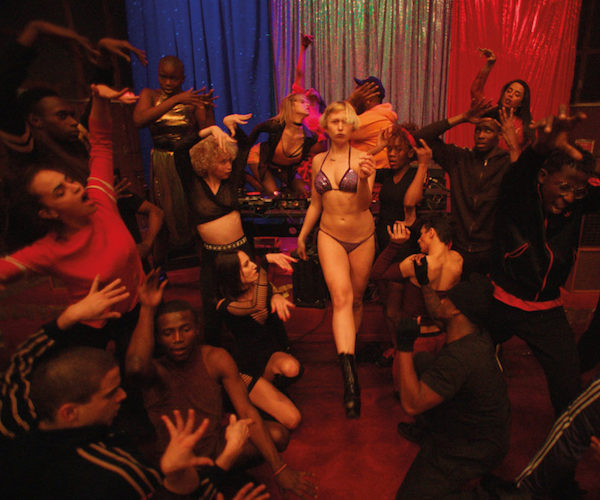Film Review: “Climax” — Mental Blitzkrieg, Cinematic Version
By Tim Jackson
Climax may be the director’s most fully realized attempt so far to suggest a state of madness onscreen.
Climax, directed by Gaspar Noé. Screening at Kendall Square Cinema, AMC Boston Common 19.

Sexual chaos: a scene from “Climax.”
Provocatively titled Climax, the latest film from Argentinian born French filmmaker Gaspar Noé is nearly devoid of plot. We’re plunged into a hallucinatory madhouse and there is no escape. Claiming to be ‘based on real events,’ the crazed narrative deals with a troupe of dancers whose party punch has been spiked with LSD. The members go bonkers and we are dragged right along with them. Noé wants to alter our consciousness via shock-a-rama sensationalism, propelled by a point of view camera that is unhinged from reality: aerial shots, garish colors, and extended sequences wallow in chaos and darkness. A soundtrack with music by, among others, Aphex Twin and Daft Punk’s Thomas Bangalter, throbs relentlessly. The cast made up of multiracial and gender fluid actors and dancers twist and contort as the party de-evolves deeper into delirium. The effect is visceral and unnerving Think what you will of Climax — crass horror exploitation, the celluloid equivalent of rubbernecking at a car crash — the director is out to expand your mind,
Climax opens with a white screen, which turns out to be an overhead shot of a field of snow into which crawls women dragging a trail of blood. (This story is not going to end well.) Noé has a taste for doing things backwards, so early on he tells us that the movie “we’ve seen” is “truth based.” A series video testimonials appear. An unseen narrator questions dancers individually about their lives and ambitions. All of this is meant to disorient us — and it does. Are we learning about the characters who will soon be marauding through the drug-induced landscape? Or are we listening to the auditions of the dancers who were cast in the film? Stacks of books and DVDs surround the television monitor, including Argento’s Suspiria, Pasolini’s Salò 120 Days of Sodom, Gerald Kargl’s 1983 film Schizophrenia (Angst), Kenneth Anger’s The Inauguration of the Pleasure Dome, Bunuel/Dali’s Chien Andalou, and Andrzej Żuławski’s 1981 horror film Possession.
Most of Climax was shot in a youth center in Vitry-sur-Seine, which doubles as the location for the dance troupe’s rehearsals and parties. The performers’ conversations include crude and enthusiastic allusions to sodomy, brutal sexual conquest, and STDs. The same ambitious young artists who were interviewed earlier are now bristling with sexual angst and hostility. Cups of sangria spiked with LSD are passed around. The irrational delusions set in and that kicks off a long tracking shot (or the illusion of one) that stalks through the kinky action: couplings, assaults, and dream visions. The roaming Steadicam of cinematographer Benoît Debie (who also shot Noé’s Enter the Void) basks in the claustrophobia generated by a series of cul-de-sac spaces. The camera spins through multi-colored rooms, where we witness disturbing acts of violence as well as deranged dancing. To orient the dancers, choreographer Nina McNeely “showed them a montage created from YouTube clips of real people on drugs, public freak-outs, nervous breakdowns, etc. Basically anything that showed people on the edge of sanity.” She succeeded: the dancing and physical contortions here are remarkable. It’s Bob Fosse’s All That Jazz meets Ken Russell’s The Devils.
Climax is not for everyone. And even those who are intrigued should be warned: it is as if Lars von Trier made one of those “Reefer Madness” films on the dangers of LSD, or maybe Roger Corman produced an upscale version of The Trip. But Noé is a provocateur, not a preacher. His work is consistent. He wants to dramatize maximum psychological engagement with the darker spaces in the human imagination. His first feature, I Stand Alone, put audiences deep into the mind of a butcher who went insane. That film did not go far enough, apparently, and Noé has not given up. Climax may be his most fully realized attempt so far to suggest a state of madness onscreen.
I recall seeing Noe’s film, Irreversible (2002), at the Harvard Film Archives before it received distribution. Given its use of reverse chronology and an unedited graphic rape scene, I thought the film would never be distributed in the U.S. To my surprise, the movie was released and its acceptance by young audiences proved that there was a hunger to see the envelope pushed. Enter the Void (2009) ran nearly 3 hours. I recall that at the end of a screening I attended the audience, mostly in their 20s and 30s, sat silently — their mouths agape. I decided to clap, and the people around me broke into applause. Climax will have the same blitzkrieg effect: either you will be challenged and mesmerized or you head home and want to take a shower.
Tim Jackson was an assistant professor of Digital Film and Video for 20 years. His music career in Boston began in the 1970s and includes some 20 groups, recordings, national and international tours, and contributions to film soundtracks. He studied theater and English as an undergraduate, and has also has worked helter skelter as an actor and member of SAG and AFTRA since the 1980s. He has directed three feature documentaries: Chaos and Order: Making American Theater about the American Repertory Theater; Radical Jesters, which profiles the practices of 11 interventionist artists and agit-prop performance groups; When Things Go Wrong: The Robin Lane Story, and the short film The American Gurner. He is a member of the Boston Society of Film Critics. You can read more of his work on his blog.
